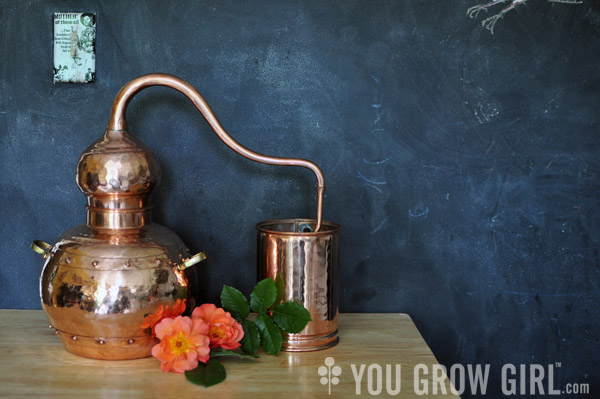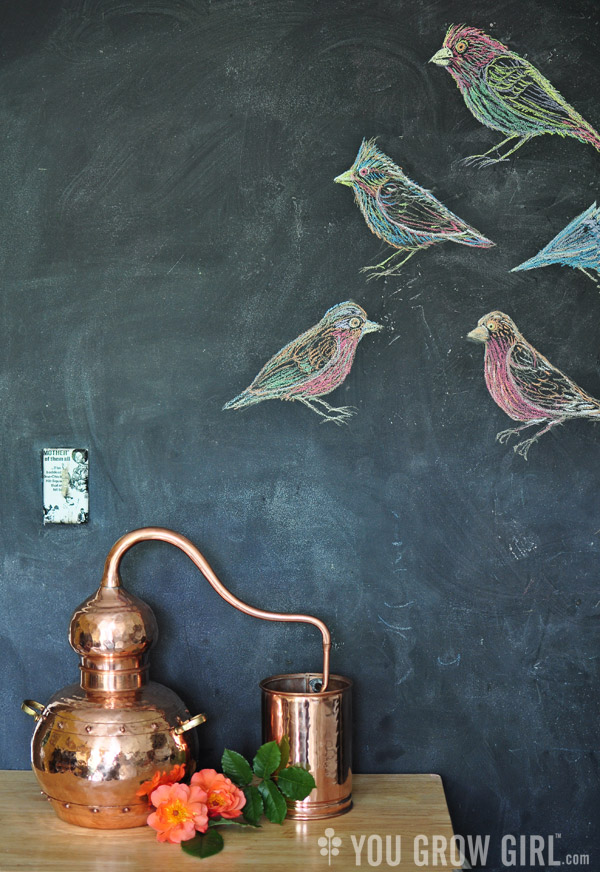
I got a handmade wooden pinhole camera for my 30th and now, with a month left before I turn 40, I have gifted myself this beautiful handmade alembic copper still from Portugal.
I’ve been doing a lot of wildcrafting this season and have been experimenting with D.I.Y methods for making plant hydrosols aka floral waters (although not only using flowers) from plant materials grown in my garden. Having tried and tried again repeatedly and having achieved some successes, but still not completely satisfied with the results, I got the crazy idea to buy an old-fashioned copper still and do it up proper. [I will write about what I learned through these experiments at another time.]
And so, I spent one afternoon last week madly researching the right contraption for my needs (and within my budget, which is always frugal). Since I WILL NOT be distilling spirits (which is illegal and frankly I am far too paranoid about the dangers involved) and I will not be making essential oils because it requires far more plant material than I can grow in my small garden, I decided to go with this beauty, a barebones, 5L copper still that can be used on a stovetop or outdoors on a hotplate.

A few points that factored into my purchasing decision:
- In case you are curious, my still cost $150 (including shipping) + a $35 customs fee on arrival. Anything larger or with different shapes or add-ons cost more. I felt this was the most I could invest given I don’t yet know how much I will end up doing this. If you’re in the US, you can purchase from this company, which will make the customs issue NIL. Since I am in Canada, I bought directly from the company in Portugal that crafts them.
- I chose to go with the old-fashioned onion-shaped alembic still because it is beautiful and I love the connection to an older way of doing things.
- No thermometer: I decided to save money and forgo the extra cost of a still with a built-in thermometer because from what I could gather the thermometer is essential when distilling spirits (you absolutely must monitor temperatures carefully for safety and quality), but when making floral waters it seems as if the emphasis is on whether or not the water has reached the boiling point. Mine came with an external thermometer, but I have absolutely no idea where it is meant to go.
- Also related to temperature is making sure that the coils where the floral water comes out is cool at all times. This had no bearing on my choice in a model, but I thought I’d mention that as I’m sure this has been one factor on the so-so outcome of my D.I.Y experiments.
- Models with an elongated, “swan neck” are more appropriate for making essential oil, but I am not doing that. Should I ever have the means (or interest) to produce essential oil, I will invest in a larger still with a different shape.
- You need a much larger still to make any real amount of essential oil — my small still might make a drop or two. But again, I’m not doing this so a smaller, 5L still should be fine.
- I considered purchasing a still built onto an electric hotplate, but decided that it made more sense to buy my own to make it easier to transport to a friend’s house, etc. This way I have a choice as to where I use it.
- My one regret is that I went with a riveted unit and I am now concerned about leaks and wonder if I should have gone with one that uses a larger copper sheet and doesn’t have as many potential gaps. That is something I will find out when I do the first cleaning flush.
Had I not cut off a gruesomely large bit of the tip of the index finger on my left hand (chopping borage no less) over the weekend, I would be putting this thing to the test right now. But alas it needs to be cleaned first and I can’t do that alone given my current one-handed condition. Hopefully I will have some help by the weekend so that I can catch the last flush of fresh rose and linden blossoms.
I’ll report back once I’ve had some time to experiment and can come to a clear assessment between the product this turns out versus the batches I have made with my cobbled-together D.I.Y setup.
I will be following this new experiment/project of yours with great interest. As someone that does not drink any alcohol, I’ve always wished there was some way to make herbal concoctions without the inevitable “add to 1 pint of vodka”. Please keep us updated. Can’t wait to hear how it works out. And that still is BEAUTIFUL. It would look lovely on my kitchen shelf. Just give me an excuse to buy one please.
I have never heard of any of this!
And I call myself a gardener!
The still is a work of art and so eye-pleasing. That looks like Rose ‘Westerland’ in the photo with it.
Best wishes for fast healing of your finger injury. Yikes-
I’m with Beverly, I’ve not heard of this either, but gosh darn that still is a pretty piece of artwork if nothing else!
I will pray for your finger.
So sorry about your finger!
This thing is beautiful! I had no idea you can actually afford even a small one. I’m totally sending the link to my friend who is into natural oils and lives in Moldova too, where they are drowning in roses and lavender right now :)
Thank you for sharing!
I love the copper still it is a special way to get pure clean clear drinking water.
I’ve never made anything more than water infused with mint or lemon balm. I am utterly intrigued!! I can’t wait to read more about this!
This is a great and commonsensical approach to create the plant hydrosols at home. Very nice read.